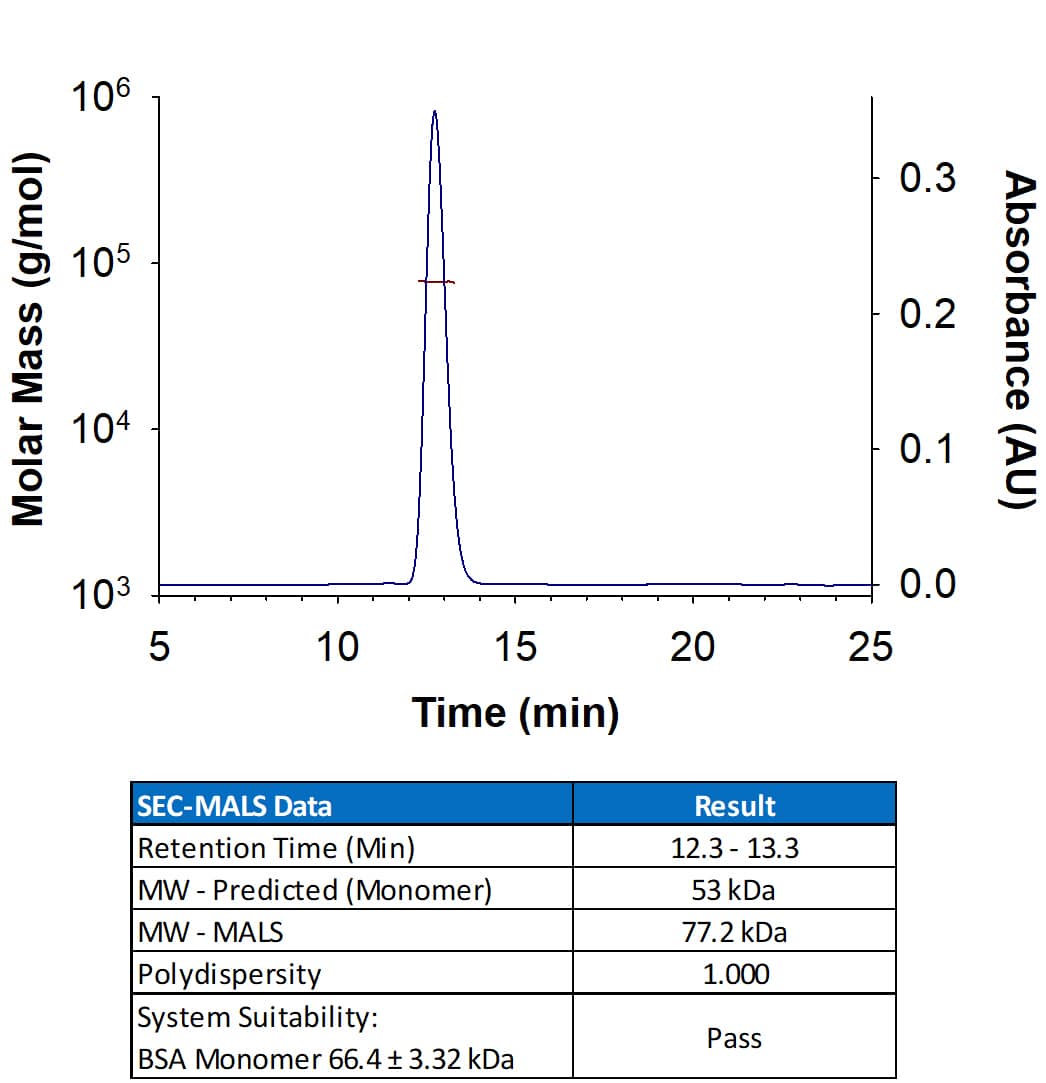Recombinant Mouse Mer His-tag Protein, CF
Recombinant Mouse Mer His-tag Protein, CF Summary
- R&D Systems HEK293-derived Recombinant Mouse Mer His-tag Protein (11313-MR)
- Quality control testing to verify active proteins with lot specific assays by in-house scientists
- All R&D Systems proteins are covered with a 100% guarantee
Product Specifications
Glu23-Ser496, with a C-terminal 6-His tag
Analysis
Product Datasheets
Carrier Free
CF stands for Carrier Free (CF). We typically add Bovine Serum Albumin (BSA) as a carrier protein to our recombinant proteins. Adding a carrier protein enhances protein stability, increases shelf-life, and allows the recombinant protein to be stored at a more dilute concentration. The carrier free version does not contain BSA.
In general, we advise purchasing the recombinant protein with BSA for use in cell or tissue culture, or as an ELISA standard. In contrast, the carrier free protein is recommended for applications, in which the presence of BSA could interfere.
11313-MR
| Formulation | Lyophilized from a 0.2 μm filtered solution in PBS with Trehalose. |
| Reconstitution | Reconstitute at 500 μg/mL in PBS. |
| Shipping | The product is shipped at ambient temperature. Upon receipt, store it immediately at the temperature recommended below. |
| Stability & Storage: | Use a manual defrost freezer and avoid repeated freeze-thaw cycles.
|
Scientific Data
 View Larger
View Larger
Recombinant Mouse Mer His-tag (Catalog # 11313-MR) has a molecular weight (MW) of 77.2 kDa as analyzed by SEC-MALS, suggesting that this protein is a monomer. MW may differ from predicted MW due to post-translational modifications (PTMs) present (e.g. Glycosylation).
 View Larger
View Larger
Measured by its binding ability in a functional ELISA. When Recombinant Mouse Mer His-tag Protein (Catalog # 11313-MR) is immobilized at 2.00 µg/mL (100 µL/well), Recombinant Mouse Gas6 (Full Length) Protein (8310-GS) binds with an ED50 of 1.00 - 6.00 µg/mL
 View Larger
View Larger
2 μg/lane of Recombinant Mouse Mer His-tag Protein (Catalog # 11313-MR) was resolved with SDS-PAGE under reducing (R) and non-reducing (NR) conditions and visualized by Coomassie® Blue staining, showing bands at 90-102 kDa.
Reconstitution Calculator
Background: Mer
Tyrosine-protein Kinase Mer, also known as c-Mer and MerTK, is a member of the receptor tyrosine kinase subfamily TAM (Tyro3, Axl, and Mer). Mature mouse Mer consists of 478 aa extracellular domain, 21 aa transmembrane domain, and 475 aa cytoplasmic domain. Within the extracellular domain, mouse Mer shares 77.1% and 90.4% homology with human and rat Mer, respectively. Similar to Axl and Tyro3, the extracelluar domain of Mer contains two Ig-like motifs and two fibronectin type III motifs. Mer is not expressed in normal B- and T-cells but expressed in neoplastic B- and T-cell lines (1-2). It is also show higher expression in immunosuppressive M2‑like macrophages (3). Mer is known to bind Gas6, Protein S, Tubby, Tubby-like protein 1 (Tulp1), and Galectin-3 (4-7). Upon binding ligands via the Ig-like motif, Mer is dimerized to trans-autophosphorylate the kinase domain to induce downstream signaling. It has been shown that Mer signaling in macrophages induces M2 polarization, which promote tumor growth, metastasis and evasion of anti-tumor immunity in tumor microenviroment (8). Inhibition of Mer, especially on leukocytes and macrophages, is an effective anti-cancer therapy (9).
- Graham, D.K. et al. (1994) Cell Growth Differ. 5:647.
- Graham, D.K. et al. (2006) Clin. Cancer Res. 12:2662.
- Shibata, T. et al. (2014) J. Immunol. 192:3569.
- Nagata, K. et al. (1996) J. Biol. Chem. 271:30022.
- Uehara, H. et al. (2008) J. Immunol. 180:2522.
- Caberoy, N.B. et al. (2010) EMBO J. 29:3898.
- Caberoy, N.B. et al. (2012) J. Cell Physiol. 227:401.
- Kim, S.Y. et al. (2016) Sci. Rep. 6:29673.
- Cummings, C.T. et al. (2013) Clin. Cancer Res. 19:5275.
FAQs
No product specific FAQs exist for this product, however you may
View all Proteins and Enzyme FAQsReviews for Recombinant Mouse Mer His-tag Protein, CF
There are currently no reviews for this product. Be the first to review Recombinant Mouse Mer His-tag Protein, CF and earn rewards!
Have you used Recombinant Mouse Mer His-tag Protein, CF?
Submit a review and receive an Amazon gift card.
$25/€18/£15/$25CAN/¥75 Yuan/¥2500 Yen for a review with an image
$10/€7/£6/$10 CAD/¥70 Yuan/¥1110 Yen for a review without an image
